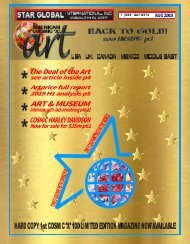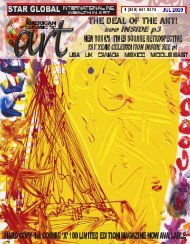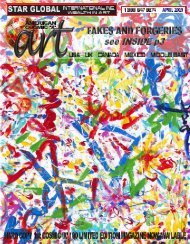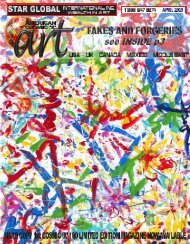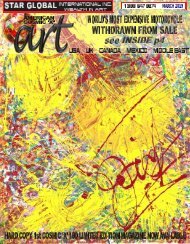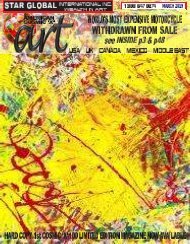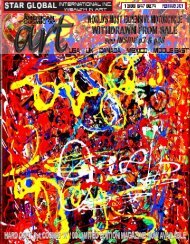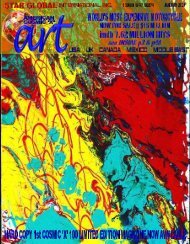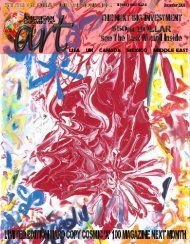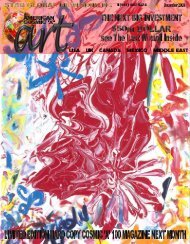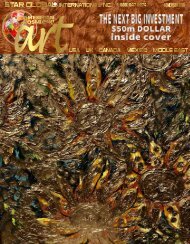SG MAG AUG 2019 MAIN_1
Create successful ePaper yourself
Turn your PDF publications into a flip-book with our unique Google optimized e-Paper software.
“There are no Fakes” is the title of a hot new Canadian documentary that features an estimated $30 million in fraudulent art sales –<br />
The Morrisseau Forgeries. One of the art dealers in the film says that there could be as many as 3,000 paintings involved in this fraud over<br />
the last few decades. This highlights a huge problem for the art world where many fakes and forgeries look as old as the originals and many<br />
galleries, dealers, museums and collectors are fooled. However, there is usually some small detail in the provenance that exposes the<br />
forgery but it often escapes even the experts. It’s caveat emptor for the most part i.e. the buyer is solely responsible for the purchase as<br />
long as the dealer acts in good faith. An authenticated painting sells at a huge multiple to a questionable one. The stakes are very high!<br />
Han van Meegeren (1889-1947) is an interesting case of fakes. He was so offended by criticism, that his work was<br />
unoriginal, he created a new and original work, Supper at Emmaus, by the great master Johannes Vermeer. He<br />
intended to declare his hoax once the painting was authenticated as a masterpiece but he never made that<br />
declaration. A Dutch gallery bought it and used it as a centerpiece for an exhibition. Meegeren went on to forge<br />
others. In 1945 he sold one of his fake Vermeers to Nazi Leader Hermann Goering. After the war he was charged<br />
with selling a work of national importance to a member of the Nazi party. In his defense he had to admit his forgery. He became world<br />
famous as the man who swindled Goering. The world may have been fooled forever, if not for this confession.<br />
Michelangelo started his career as an art forger albeit that he was an extremely skillful artist. He created a number<br />
of statues, including one called the Sleeping Cupid, when he was working for Lorenzo di Pierfranseco. Another<br />
eminent forger was one Elmyr de Hory who sold over 1000 fakes by famous artists such as Picasso, Matisse and<br />
others. It is indeed ironic that his own works are now sought after and forgeries claimed to be forged by him have<br />
begun to appear in auctions. There are many more examples of forgeries. It really is a crazy art world!<br />
There is no doubt that the Art Business is Big Business making the gamble worthwhile.<br />
Once a painting is authenticated as a masterpiece it can attract a huge price in a gallery or<br />
at an auction house. It’s a big payday for both dealers and auction houses. Many questionable<br />
paintings never come to light because the buyers have no interest in finding out afterwards that they have a<br />
worthless painting. Police estimate that up to 50% of the art sold on the international market may be forged.<br />
Major museums may be holding collections that are about 20% fake. In April 2018, a French museum discovered<br />
that 82 of their 140 Etienne Terrus paintings were fakes.<br />
Artists often receive only a small fraction of the hammer prices for their valuable artworks and some artists are fighting back. One such<br />
artist, Jack Armstrong, from his early days in New York as a model and artist, shunned the Galleries and Auction houses. He called them the<br />
“Art Cartel.” He says that they sell factory art—art reproduced by lowly paid artists then signed by their own, gallery promoted, artist.<br />
Armstrong proved that it’s possible to break through this art establishment wall and self-promote, selling million dollar art. Alice Walton<br />
owns two originals. Armstrong’s Cosmic X art, a style he founded, and painted only 100, is virtually impossible to forge. This extremely<br />
limited production makes them easy to track. His paintings also contain his fingerprints, handprints and DNA.<br />
Star Global International Inc. has been promoting Armstrong’s works for nearly a decade after rocketing him to art star status with their<br />
“Million Dollar Harley” promotion. Armstrong painted this V-Rod Harley Davidson it is the most expensive motorcycle in the world. There<br />
are no Gallery showings or Auction prices yet over 50% of his paintings are already in private hands with no eager sellers. This will change<br />
and a secondary market will evolve. The extremely limited production will cause his prices to skyrocket. His current prices range from $5<br />
million to $50 million. Millions of people have seen his works many of which are currently promoted in a Digital retrospective in New<br />
York’s Times Square just above the main entrance of Ripley’s. The artist claims his paintings will eventually sell in the $100 million ranges<br />
alongside those of his contemporaries and friends from his New York sojourn in the early 80’s. Armstrong was a friend of Andy Warhol who<br />
called him The Last Wizard, Jean Michel Basquiat and Keith Haring. Star Global are able to authenticate any Armstrong painting and<br />
represent several of the paintings. We currently have two for sale and welcome all enquiries.<br />
21






